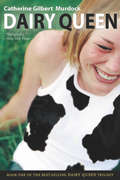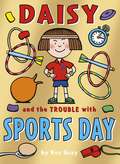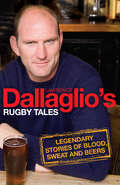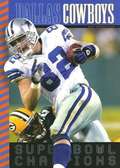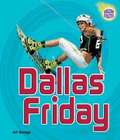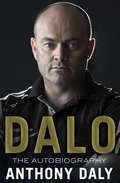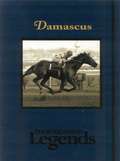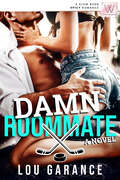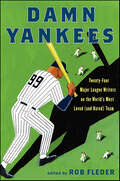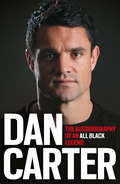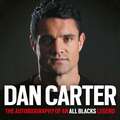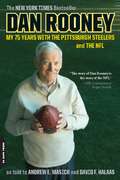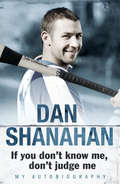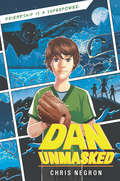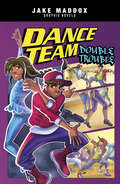- Table View
- List View
Dairy Queen (Dairy Queen Trilogy Ser.)
by Catherine Gilbert MurdockWhen you don't talk, there's a lot of stuff that ends up not getting said.Harsh words indeed, from Brian Nelson of all people. But, D. J. can't help admitting, maybe he's right.When you don't talk, there's a lot of stuff that ends up not getting said.Stuff like why her best friend, Amber, isn't so friendly anymore. Or why her little brother, Curtis, never opens his mouth. Why her mom has two jobs and a big secret. Why her college-football-star brothers won't even call home. Why her dad would go ballistic if she tried out for the high school football team herself. And why Brian is so, so out of her league.When you don't talk, there's a lot of stuff that ends up not getting said.Welcome to the summer that fifteen-year-old D. J. Schwenk of Red Bend, Wisconsin, learns to talk, and ends up having an awful lot of stuff to say.
Daisy and the Trouble with Sports Day (A Daisy Story #9)
by Kes GrayDaisy's getting into trouble again, and this time it's at her school Sports Day! Daisy's determined to win her race, and she and best friend Gabby have been training hard. They're going for gold! They're in the zone! They're sticking to a strict athlete's diet of Mars bars, Twiglets and cheese strings! Trouble is, everyone else in the class wants to win too . . .
Dale Earnhardt
by A. R. SchaeferLearn about Dale Earnhardt's early racing career and how he beat out the competition to race to the top of the NASCAR record books.
Dale Earnhardt Jr.
by Jeff SavageAlthough he started his career in his father's shadow, Dale Earnhardt Jr. has proven that he earned his standing as one of NASCAR's top racers, and that this third-generation driver will not stop until he's the best.
Dale Earnhardt Jr., 3rd Edition (Amazing Athletes Ser.)
by Jeff SavageDale Earnhardt Jr. has been auto-racing royalty since he was born. Dale Jr.'s father was the legendary Dale Earnhardt. Dale Jr. has carried on the Earnhardt family winning tradition since his father was killed in a racing accident in 2001. Dale Jr. won NASCAR's biggest race, the Daytona 500, in 2004. Then he did it again in 2014. Find out more about this racing hero who is creating his own legacy on the track.
Dale Earnhardt Jr.: Out of the Shadow of Greatness
by Mike HembreeDale Earnhardt Jr.’s name virtually assured that his life would not be ordinary. Over the past decade, he has fulfilled that destiny. His father, one of the most successful drivers in the history of international motorsports, gave his son more than his name. Dale Earnhardt Sr. placed Dale Jr. in position to follow the footsteps and tire tracks he had left from Darlington to Daytona, from coast to coast, from one championship to the next. Entering 2001, Junior was set to turn the sport on its ear. Instead, his world was rocked in the first race of the season when Dale Sr., racing behind him in a wild finish to the Daytona 500, crashed into the outside wall and was killed. The racing world mourned, and Junior’s life changed in many ways. Dale Earnhardt Jr.: Out of the Shadow of Greatness tells the story of this remarkable young man’s journey from teenage dreamer to Winston Cup winner, from Street Stock racer to 200 mph superstar, from son of the greatest to a champion in his own right. Against the backdrop of one of sport’s biggest tragedies, he continues to carry the Earnhardt name to new heights. This newly revised edition is a must for any NASCAR fan.
Dale Earnhardt Sr. (Legends in Sports): Matt Christopher Legends in Sports
by Matthew F ChristopherDale Earnhardt, Sr. first broke onto the racing scene in 1979, when he was named Rookie of the Year. In the more than 20 years that followed, his daring driving style earned him several top honors, including his proudest moment, a victory at Daytona. On February 18th, 2001, Earnhardt had been racing in the Daytona 500, when in the final lap, he had a fatal crash. While other drivers have come and gone, the face of Dale Earnhardt, Sr. , with his handlebar moustache and wide grin, will always be the face of NACAR. Get to know a legend.
Dale Earnhardt: Young Race Car Driver (Childhood of Famous Americans Series)
by Paul MantellA fictionalized biography of the childhood of the famous NASCAR racer.
Dallaglio's Rugby Tales
by Lawrence DallaglioIn RUGBY TALES, Lawrence Dallaglio recalls with affection and razor-sharp humour, the behind-the-scenes stories that have previously only been shared within the world of international rugby, together with some classics from his rugby-playing colleagues and mates.There's the one about the 2003 World Cup winner who curtseyed to the queen and another featuring the rugby legend who was affronted by the suggestion that he had been out on the town until 3 a.m. days before a crucial match. 'Don't you look at me,' he cried indignantly, 'I got in at six.' Featuring big games, bigger personalities, quick-fire banter and the odd pint or two, these are the best of the best from the legends of the dressing room, pitch and pub.
Dallaglio's Rugby Tales
by Lawrence DallaglioIn RUGBY TALES, Lawrence Dallaglio recalls with affection and razor-sharp humour, the behind-the-scenes stories that have previously only been shared within the world of international rugby, together with some classics from his rugby-playing colleagues and mates.There's the one about the 2003 World Cup winner who curtseyed to the queen and another featuring the rugby legend who was affronted by the suggestion that he had been out on the town until 3 a.m. days before a crucial match. 'Don't you look at me,' he cried indignantly, 'I got in at six.' Featuring big games, bigger personalities, quick-fire banter and the odd pint or two, these are the best of the best from the legends of the dressing room, pitch and pub.
Dallas Cowboys (Super Bowl Champions)
by Nate LeboutillierProfiles the Dallas Cowboys football team and their Super Bowl championships in 1971, 1977, 1992, 1993, and 1995.
Dallas Friday
by Jeff SavageIntroduces the life and accomplishments of the famous wakeboarder, Dallas Friday.
Dalo: The Autobiography
by Anthony DalyAnthony Daly was the most successful captain in the history of Clare hurling, leading the county to two All-Irelands and three Munster titles. Regarded as an inspirational figure by his fellow players, Daly’s innate leadership and character prompted the Clare players, just three years after he had finished his playing career, to pursue him as manager at the age of just 34. During his three years in charge, he took Clare to the cusp of two All-Ireland finals, agonisingly losing the 2005 and 2006 semi-finals to the eventual winners, Cork and Kilkenny. It was that kind of ambition and drive to succeed which attracted Dublin hurling to Daly. Taking over the county in 2009, he led Dublin, in 2011, to their first National League title in 72 years and, in 2013, their first Leinster title in 52 years, before he retired as manager in September 2014.Dalo takes us from the early days growing up in Clarecastle through the early part of his career with Clare, the golden years and the extension into management, punctuated with intense and revealing stories from the dressing-room. Interlaced with drama, tragedy, his love of other pursuits, and his immense wit, Anthony Daly’s autobiography offers a compelling insight into a unique personality in modern Irish sport.
Damascus (Thoroughbred Legends #22)
by Lucy HeckmanDamascus ranked as one of the superstars of the memorable era of horse racing in the late 1960s. He thrilled fans with his trademark sweeping move on the far turn and relentless stretch run that left his opponents floundering. Damascus was much like the steel blades he was named for —tough and resilient. He could combine devastating power and acceleration to cut down his opponents as he forged his way to victory. Author Lucy Heckman recounts Damascus’ amazing career, including his 1967 championship three-year-old season. That year he faced his toughest opponents, the brilliant Dr. Fager and Buckpasser, in the Woodward Stakes. Called “The Race of the Century,” the Woodward became Damascus’ defining moment as he powered away from his rivals for a breathtaking triumph. Trained by Hall of Famer Frank Whiteley Jr. and ridden by the legendary Bill Shoemaker, Damascus thrilled race goers with his patented stretch runs, his rivalry with Dr. Fager, and most of all, his great courage as he vanquished foe after foe.
Damn Roommate: a slow burn spicy romance
by Lou GaranceFalling for your brother’s best friend? Not a good idea! Moving in with him? Even worse! When she moves in with her brother’s roommate and his group of friends, Scarlett feels like she’s really in for it. She couldn’t get Nolan Jones out of her head while living thousands of miles away from him, so how could she possibly forget him now that she’s back in Boston? Especially now that she occupies the room right next to his? Yet her lifelong crush gives her no reason to hope. Nolan teases her like she’s his little sister! Scarlett knows she has to accept that he will never see her otherwise. But between the evenings spent challenging each other, the unsettling closeness on the couch and the new spark she sees in Nolan’s eyes, never might be coming sooner rather than later.
Damn Yankees: Twenty-Four Major League Writers on the World's Most Loved (and Hated) Team
by Rob FlederWinners of twenty-seven World Series titles, the New York Yankees are the quintessential sports dynasty. Love them or hate them, they cannot be ignored by anyone who professes to be a fan of the great game of baseball.With Damn Yankees, Rob Fleder, former Executive Editor for Sports Illustrated magazine, offers a timeless collection of original essays by some of the most prominent contemporary writers in America—from Pete Dexter to Jane Leavy, from Roy Blount Jr. to Colum McCann—each piece focusing on one uniquely colorful subject: the fanatically adored/resoundingly despised “Bronx Bombers.”Funny, moving, provocative, insightful appreciations and detractions—from Babe Ruth to Mickey Mantle to Derek Jeter—Damn Yankees offers twenty-four fascinating takes on the most storied franchise of baseball’s Major Leagues.
Dan Carter: The Autobiography of an All Blacks Legend
by Dan CarterDan Carter's last game as an All Black culminated with him declared Man of the Match following the 2015 Rugby World Cup final at Twickenham - an unforgettable ending to the career of the greatest fly-half of all time.But along with the triumphs of his signature World Cup win, his performance against the Lions in 2005, and an unprecedented run of Bledisloe Cup successes, there was also the pain and doubt he felt during a prolonged period of injury and rehab following the 2011 World Cup.He watched that victory from the sidelines, as he had the All Blacks' defeats in two previous tournaments. Indeed, heading into the 2015 World Cup he had never finished the competition on his own terms.His autobiography tells of that redemption, and gets you up close and personal with one of the most celebrated sportsmen of our time.Threaded throughout the book is an intimate diary of his final year as a Crusader and All Black, during which he worked tirelessly to make one last run at that elusive goal: a World Cup victory achieved on the field.Dan Carter's autobiography is essential reading for all sports fans.
Dan Carter: The Autobiography of an All Blacks Legend
by Dan CarterDan Carter's last game as an All Black culminated with him declared Man of the Match following the 2015 Rugby World Cup final at Twickenham - an unforgettable ending to the career of the greatest fly-half of all time.But along with the triumphs of his signature World Cup win, his performance against the Lions in 2005, and an unprecedented run of Bledisloe Cup successes, there was also the pain and doubt he felt during a prolonged period of injury and rehab following the 2011 World Cup.He watched that victory from the sidelines, as he had the All Blacks' defeats in two previous tournaments. Indeed, heading into the 2015 World Cup he had never finished the competition on his own terms.His autobiography tells of that redemption, and gets you up close and personal with one of the most celebrated sportsmen of our time.Threaded throughout the book is an intimate diary of his final year as a Crusader and All Black, during which he worked tirelessly to make one last run at that elusive goal: a World Cup victory achieved on the field.Dan Carter's autobiography is essential reading for all sports fans.(P)2015 Headline Digital
Dan Carter: The Autobiography of the All Blacks Legend
by Dan CarterThis is the up-close-and-personal memoir of a global icon of sport, a country boy who went on to become rugby's world superstar. Daniel Carter is acknowledged as the greatest fly-half to have played international rugby. A veteran of more than 100 Test matches, he is the world record holder for most Test points, has twice been named the IRB's Player of the Year and twice named New Zealand Player of the Year. Legendary unbeaten All Blacks coach, Sir Fred Allen, who followed international rugby from the 1920s until after the 2011 Rugby World Cup, had no hesitation in naming Carter as the greatest fly-half he ever saw. Carter, though, is renowned for his modesty and unassuming nature, and argues that he has he always 'just tried to do the best job I can for the All Blacks'. In My Autobiography, the great All Blacks pivot with the model good looks opens up for the first time about his stellar 12-year career. He looks back on the myriad highs, including that virtuoso performance against the Lions in the second Test of the 2005 series when he scored a record 33 points. (The Guardian described the performance as 'the definitive fly-half display of the modern era.') With an equal measure of honesty, he reflects on the lows of his career, speaking frankly of the mental anguish he felt after twice being invalided out of Rugby World Cups. He also talks about his unflinching loyalty to the famous black jersey and the reasons why he elected to make a long-term commitment to New Zealand.
Dan Rooney: My 75 Years with the Pittsburgh Steelers
by Dan Rooney Andrew E. Masich David F. HalaasIn 2007, the Pittsburgh Steelers will turn seventy-five years old. So will Dan Rooney. In Dan Rooney, the owner talks about growing up on Pittsburgh's North Side, competing with Johnny Unitas for top high school quarterback honors in western Pennsylvania, learning the ropes of big-time sports from his father and mentor, Art Rooney ("the Chief"), helping to shape the modern NFL into America's all-consuming passion, and forging the Steelers into a Super Bowl-winning dynasty. He also speaks frankly about winning and losing, and discusses his relationships with family, coaches, players, owners, NFL commissioners, the media, and the fans-"Steeler Nation. " It's all here: the difficult contract negotiations, controversial decisions, memorable teams, and many behind-the-scenes stories of the growth of America's favorite game. A dedicated family man and proud native of Pittsburgh, this chairman of one of the most successful franchises ever reveals the dynamics that have made him such a respected owner in the NFL.
Dan Shanahan - If you don't know me, don't judge me: My Autobiography
by Dan ShanahanDan Shanahan is a legend in modern hurling, a three-time All Star and winner of 'Player of the Year' in 2007. His time as an inter-county senior hurler coincided with the remarkable revival in Waterford's fortunes, which saw them win the Munster Final four times in the last decade.In this candid and revealing autobiography, Dan speaks about his love of the game, which grew out of an idyllic childhood in Lismore and his apprenticeship with the Lismore club. He first made his mark as a senior player with Waterford in 1998, under the management of Gerald McCarthy. But it was when Justin McCarthy took over as manager in 2002 that the Waterford team really began to shine, Dan sharing the glory with such outstanding players as Tony Browne, Eoin Kelly, John Mullane and Ken McGrath. Yet tensions between the players and manager built up in 2007/2008, culminating in a frustrated Dan famously refusing to shake Justin's hand in public. McCarthy resigned and was replaced by Davy Fitzgerald, who led Waterford to the 2008 All-Ireland Final.Dan's charisma and extraordinary goal-scoring ability earned him a place in Waterford hearts. His goal in extra time in the 2010 Munster Final against Cork proved what a vital player he remained, and was a fitting climax to a great career. He retired from inter-county hurling shortly after.A tattoo on Dan's arm reads: If you don't know me, don't judge me. It's a testament to Dan's determination to succeed in the face of adversity.
Dan Unmasked
by Chris NegronThis heartfelt middle grade debut about grief, creativity, and the healing power of friendship shows that not all heroes wear capes and is perfect for fans of John David Anderson and Ali Benjamin. Whether they’re on the baseball field or in Nate’s basement devouring the newest issue of their favorite comic book, Dan and Nate are always talking. Until they’re not. After an accident at baseball practice, Nate’s fallen into a coma. And if Dan ever wants to talk to Nate again, he’s got to take a page out of his hero Captain Nexus’s book, and do whatever it takes to save the day. But heroes have powers—and without Nate, all Dan has is a closet stuffed with comics and a best-friend-shaped hole in his heart. There’s no way a regular kid can save the day all on his own. Right?
Dan Walker's Football Thronkersaurus
by Dan WalkerIt was while commentating on a Goal of the Month competiton that Dan Walker uttered the immortal line: 'What a strike from Mike Sheron - what a thronker!' He'd coined the term to describe a long-range shot that blasted into the net, threatening to annihilate any passing pigeon. Since then, he has been trying to get the word accepted - if not by the OED then at least by Countdown. Hence this book has become a Thronkersaurus, a book that tells the hilarious stories of the great and not-so-great moments in footballing history. Taking his own experiences as a starting point, Walker journeys to obscure areas of football to find the most extraordinary tales. He still worries that the Barcelona scouts lost the trail when his local newspaper reported his two goals as having been scored by David Wacker instead. But then again, who was Joe Kinnear talking about when he referred to Charles Insomnia? Whether it is players sacrificing lizards to bring them luck, or the moment when Walker yelled at Pele to stop him signing some merchandise for him, this is a brilliant collection of wonderful moments and hilarious anecdotes that will surprise and and entertain all who read it.
Dance Fun (Sports Fun)
by Cari MeisterDance is fun to watch, but it’s even more fun to do! Kids can take the stage by learning what dance is, what gear and skills are needed, what happens during lessons, and how to be a good sport. A special activity helps kids build a basic dance skill.
Dance Team Double Trouble (Jake Maddox Graphic Novels)
by Jake MaddoxWhen twins Lydia and Marco are approached to be on their dance studio's jazz team, Lydia is thrilled. She and Marco both love to dance and used to have fun dancing together as kids. But lately it seems their relationship has grown more distant. Lydia can't wait to dance with her brother again, but Marco is worried. He's used to hip-hop and will be the only boy on the team. And when bullies start mocking Marco for doing "girl dances" it could spell trouble for the whole team.
